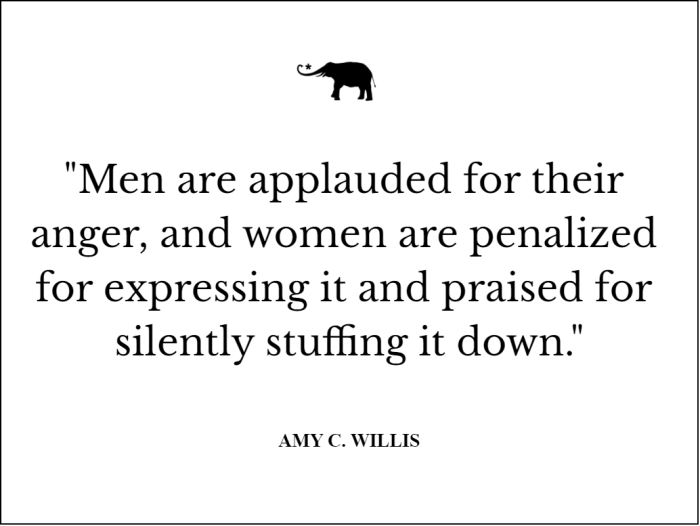Enraged. Mad. Angry. Inflamed. Livid. Infuriated. Outraged. Incensed. Vexed. Furious. Pissed.
These words are rarely used to describe women.
The unspoken but deeply ingrained societal expectations tell us that women are to show up consistently as: kind, quiet, gentle, calm, giving, in service of others (mainly men and children), supportive, comforting, loving, and of course, all with a goddamn smile on our faces.
This is what it means to be a “good” woman. From a young age, anger is insidiously cleaved from femininity and those who occupy spaces as girls and women. Because angry women are not good women. This is intentional conditioning and a strategic part of patriarchal upkeep.
While we all love to tout feminist progress—but only to the extent that demonstrates that feminism is no longer needed—we have not yet reached the pinnacle of sex and gender equality and equity.
We are all still very much entrenched in a patriarchal system that enables misogynistic and sexist beliefs and behaviors, to the detriment of everyone, largely women, with a close second being trans, gender non-conforming, and non-binary folks. And don’t even get me started on the unjust, racist, and problematic stereotype of the angry Black woman and all the consequences that go along with Black women justifiably expressing their anger.
As a reminder—and this may fly in the face of everything you believe to be true about anger—anger is simply a human emotion. It is neither good nor bad and is just as valid and legitimate an emotion to be experienced and expressed as happiness, sadness, grief, and so on.
According to Soraya Chemaly, activist, author of Rage Becomes Her: The Power of Women’s Anger and TED Talk speaker, anger is “actually a signal emotion. It warns us of indignity, threat, insult, and harm.”
I would also add to this list that anger is often a signal of boundary violations. In other words, anger is a messenger and is there to present us with vital information about our safety (emotional, physical, and otherwise) and well-being.
Anger is helpful.
When push comes to shove, women are still held to often unachievable standards, and when we fail to meet those standards, the consequences are pretty real and considerable. When women exist in and express anger, we fall outside the narrow parameters of what it means to be a “good” woman. And when this happens, our humanity is impacted negatively and those judging us feel less inclined to treat us humanely.
When it comes to anger, there is a great gender divide, and depending on who is expressing that anger, the treatment and outcome are vastly different.
In the words of Chemaly, “In culture after culture, anger is reserved as the moral property of boys and men.” Think about this. When anger is exercised by men and boys, it’s labeled as masculine, manly, leadership, and assertive. When the same emotion and emotional expression is exercised by women, we are labeled as b*tchy, mean, unfeminine, and unpleasant.
Research demonstrates that women and men experience anger at similar levels of intensity and frequency, though I would guess that women experience greater intensity in their anger and that our bouts of anger last longer, likely due to the fact that there is no socioculturally appropriate or acceptable way for women to outwardly express their rage.
Recently, I have been thinking a lot about women and rage.
Last week, I was woken up in the middle of the night to unidentifiable pounding noises in my apartment. Shortly after that, I heard the sound of glass breaking. As a single woman sleeping alone, hearing glass being broken in my home in the middle of the night was nothing short of terrifying. I grabbed my phone and sprung out of bed, walking toward where the glass had been broken. I could see a man outside one of my living room windows. He had punched my window in and was trying to unlock the window so he could enter my apartment.
I immediately started screaming at him to get away, get out of my house, and so on. I don’t even remember what else was said, but I’m deeply grateful that my “fight” (rather than my flight or freeze) response kicked in as my rage and the volume of my voice stopped him from proceeding in trying to illegally enter my apartment.
My anger was a signal that my physical safety was being threatened, and it prompted my fight response. My anger actually served to de-escalate the situation and prevent a break-in.
After that, my rage continues to be stoked by the fact that this f*cking dude knew that he was breaking into a woman’s apartment, and he chose to prioritize his entitlement (in terms of access to the building) over my privacy, safety, and security.
For context, I know who this man is, and he was attempting to break into my apartment so that he could get to his apartment (he also lives in the building) as he had locked himself out. There were other options for him in terms of places to break into (two empty offices and a lobby), and he chose my home. A “good” and polite woman, perhaps, would have let him into the building, knowing that he lived here.
And there was absolutely no way that was going to happen.
Following the attempted break-in, I continue to engage my rage in an effort to reclaim my sense of safety and security in my home. This tangibly looked like advocating for myself with my apartment building’s property managers by asking for additional safety and security measures to be taken.
This also looked like filing a report with the police (but choosing not to press criminal charges against this man) because documentation and the truth matter. I have also spent some time researching and educating myself on the various ways that I can legally protect myself in accordance with Canadian laws (FYI—there aren’t a lot of options), and ultimately, letting this experience inspire me to write this article which I hope will serve as a rallying cry for women to reconnect to our anger and to let it serve and empower us.
I would be remiss here if I didn’t also acknowledge my own privilege in wielding my anger. I am a white, able-bodied, (read as) straight, young, cis-woman living in a large, urban city in Canada. I am dripping in privilege. In the situation mentioned above, while some of my safety and security were chipped away as a result of this man punching in my window, violating my space, and trying to break into my home, I was also inside my home, which provided protection.
And I knew that if I chose to contact the police (a choice that I made after a lot of consideration), I could easily get help based on how I look and the privilege I carry. For many, conjuring up feelings of safety and security in unsafe conditions is next to impossible.
For many, contacting the police is not an option as that can often bring more harm than help, which is also based on what the person calling for help looks like and the intersections of privilege and oppression they stand at. I also want to touch on the many times that I haven’t expressed my anger because to do so would have likely led to the situation becoming more dangerous for me. This is also true for anyone in a domestic abuse situation as well. There are lots of times that the expression of anger is not in service to us as women (which is also a result of the patriarchy).
That said, this is an invitation, a call to action, a push to step into the space and embrace anger. When harnessed and used for propulsive purposes, anger can fuel change, shift relationships, topple systems, catalyze advocacy, and more. Anger can be tremendously powerful, and in a world where women are systematically deprived and stripped of power, this is our chance to take some back. Choosing to step into our power can not only be empowering, but I also believe that anger can be used for healing and reclamation purposes, especially in situations that challenge our sense of agency, security, and autonomy.
Anger can feel really scary for women to experience and tap into, especially for those of us who have had anger weaponized against us in aggressive and violent ways.
I have been on the receiving end of physical violence and verbal abuse, both of which were accompanied by rage. I intimately know the feelings and signals that arise in my body when this happens and know that it doesn’t feel good.
What I now also know though is that anger and violence are not mutually exclusive, and that anger can be expressed in a multitude of healthy and, indeed, necessary ways. Separating anger from violence and aggression will be part of your work, and it will take time, so do what you can to be patient, gentle, and curious with yourself.
If you are interested in (re-)connecting to your anger and rage, here are some suggestions:
>> Name it. Name your anger when you experience it. This is especially important if you have been in the habit of ignoring it and stuffing it down. Stuffing it down also has a cost and weight to it, and we don’t necessarily see the consequences of those costs until later on in life.
>> Express your anger to someone else. It can be as simple as saying “I’m angry because of XX” or “I’m mad that you did XX.” Name it, express it, and let it be known. This can be done in a normal speaking tone; communicating your anger doesn’t need to include being loud, though it absolutely can.
>> Try to recall stories of angry women and how they were spoken about. For example, you can think of your mother or older female adults in your life and how they a) expressed anger, if at all, and b) how it was responded to. These experiences likely shaped and informed what you believe to be true about women and rage now.
>> Make a list of the beliefs you hold to be true about women and anger. When you think of angry women, what words and images come to mind? Try not to censor your answers—we’re just gathering information here. Once you have your list of beliefs, ask yourself if those beliefs are objectively true and what would be possible for you if those beliefs weren’t true (because they may not be).
>> Notice how your body feels when you experience anger. Observe sensations, temperature changes, and so on.
>> Try to release any ideas or beliefs that you hold about anger being negative. If possible, invite in the idea that anger is neutral.
Finally, I want to invite you to remember that anger is a human emotion, and as a human, you are allowed and entitled to experience this feeling. Let it wash over you. Let it propel you. Let it empower you.
In love and fury, always.










Read 31 comments and reply